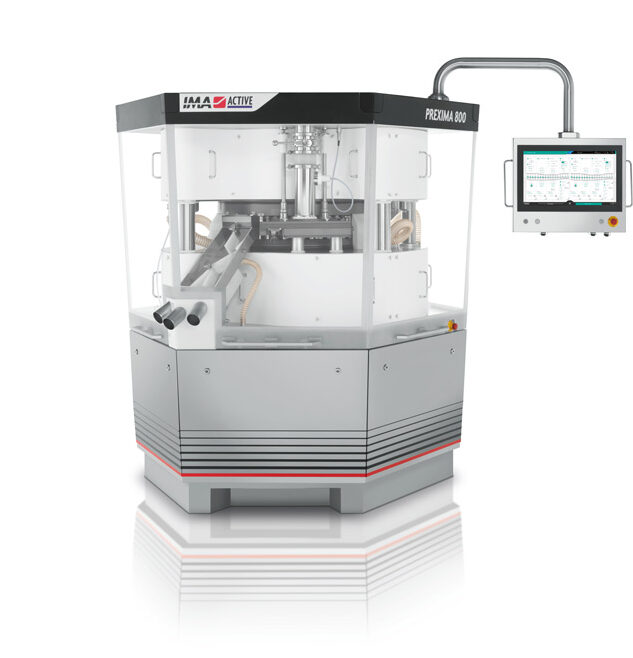
Salty compression.
Fabriano Ferrini, Product Manager for tablet presses at IMA Active |
Salt tablets are used on various home care/chemicals applications, like water softening of drinking water, swimming pools water disinfection, washing machines for dishes or clothes in households, hotels and restaurants or laundries. They can be also used as nutritional supplements for animal nutrition.
We are often approached by customers looking for new machines to expand their production of salt tablets. In this kind of application, the customer does not really care about tablet shape and size.
The main goal is to maximize machine output in terms of tons of salt compressed in the unit time.
However, process is extremely challenging because of the technical characteristics of the product and of the process itself, so to achieve the goal, specific technical solutions had to be developed.

1. Process criticalities in salt compression
To start, product is extremely abrasive and aggressive, wearing of parts both within the process area and in the mechanical area, in case the product migrate to the lower compartment. Salt tends to be hygroscopic and high water content affects powder flowability, forcing a reduction in machine speed and therefore in the output. Additionally, process needs high compression force due to the crystal nature of salt and to the high weight of the tablet itself, but lamination appears above 70 kN. The shape and size of the tablet, with high height of the band, cause sticking to the die walls and high force is needed to eject the tablet from the die. On a standard press and with standard dies, this sticking caused the die to be lifted from its seat in the die table.
This is particularly critical also because tablets, immediately after being formed, have a low hardness and can be easily damaged, both during ejection from the die and during the subsequent handling to the exit chute and then to the conveying belt to the secondary packaging station. After 10-15 minutes, tablets become very hard and can then be packed without problems in 25 kg bags.
2. Technical solutions fort salt compression
Some of the main features of Prexima are already particularly useful for this application: the complete separation between process area and lower mechanical compartment, together with the overpressure of mechanical area, avoid product penetration in lower compartment. Thus, cams and rollers are kept in a protected environment.
In the process area specific materials have been selected for parts in contact with salt: V-Ring, bellows, turret and, die table have been chosen with appropriate materials and coating to provide enhanced lasting to abrasion and chemical aggression.
Process parameters have been carefully studied together during trials with our technologist at the IMA Active Laboratory.
To enhance powder flowability and guarantee a smooth filling of the product to the dies, before being fed to the tablet press machine salt is sieved and the dried in oven to reduce water content.
• Compression force has been set at 60 kN, increasing dwell time through the use of 441 punches with large punch head.
• Upper punch penetration during compression was set as very low, to form the tablet near the upper surface of die, improving air ejection and reducing extraction forces.
The old machines that one of our customer was using are not fitted with load cells and self-adjustment feedback loop on die filling, however these features are standard on Prexima and the customer could appreciate how they make for a much more stable process, less variations in weight and compression force, and thus less stress for the machine itself.
To minimize ejection force and preserve tablet integrity, our technologist together with the technical department suggested to increase tablet diameter from 25 to 28 mm, thus decreasing tablet height.
Additionally, the machine was fitted with a special ejection cam with dedicated lubrication system.
The use of tapered dies with lower collar ensures that the dies are not lifted during tablets ejection.
Finally, ejection blade and exit chute have been modified for gentle tablet handling at machine exit, until when the natural hardening process takes place.
3. Results
These technical solutions allowed Prexima 800 to reach customer goal, manufacturing 14.5 gr tablets with round shape, 28 mm diameter and a band height of 12 mm. At 40 rpm, corresponding to an output of 4,240 tablets/minute, Prexima 800 could achieve the required production of 3.7 tons/h.
Four Prexima 800 have already been installed at different customers for salt compression, and several open project are ongoing.
Paper sections:
Last Submitted Papers
- Manufacturing DPIs: an engineering perspective
- Development of an automated multi-stage continuous reactive crystallization system with inline PATs for high viscosity process
- Fractional Fractorial Design
- Validation of Cleaning in Place
- Coating optimization: equipment features to prevent defects
- Drug layering: the impact of up-scaling
